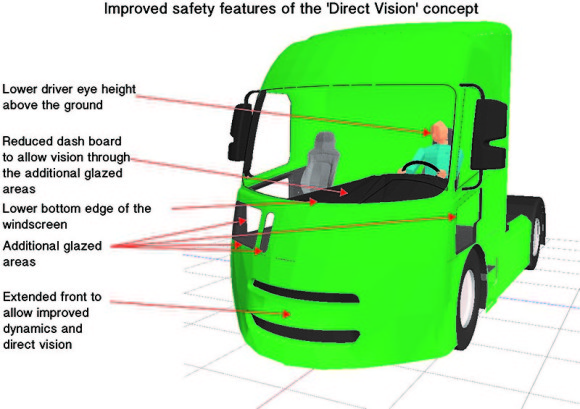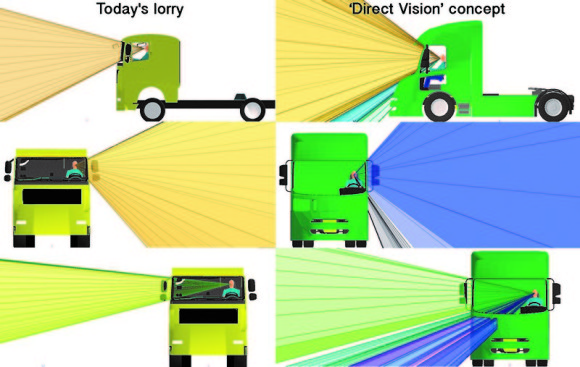
Direct-Vision Lorries could save hundreds of cyclists’ lives
#SaferLorriesNow
An 80cm longer cab with a rounded nose, smaller dashboard, expanded glazed areas and a slightly lower driver position could drastically reduce fatal blind spots [1] around the lorry cab, a new study by the Loughborough Design School [2] reveals. The ‘Direct Vision’ lorry concept would increase the driver’s field of view in front and to the sides of the lorry by 50% compared to today’s lorry designs and could save hundreds of cyclists’ and pedestrians’ lives.
According to the European Transport Safety Council, lorries are involved in around 4,200 fatal accidents in Europe every year. Many of these fatalities, almost 1,000 [3], are vulnerable road users such as cyclists and pedestrians. In countries with high rates of cycling, lorries are often the single biggest threat to cyclists: In Belgium, 43% of cycling fatalities involve larger vehicles, in Holland 38% and in the UK 33%. In some cities, like London, lorries are responsible for around 55% of cyclist deaths.
Outdated, brick-shaped lorry cabs are part of the reason why lorries have a deadly track record. Today’s cab design forces the driver to sit on top of the engine in such a high position that much of what happens around the cab is invisible to them – the so-called fatal blind spots.
Dr. Steve Summerskill, project lead of ‘Direct Vision’ concept for Loughborough Design School, said: “Blind spots can be a significant factor in fatal accidents with lorries. The study shows that the size of these blind spots can be minimised through improved cab design, the reduction of cab height and the addition of extra windows.”
There are two major issues holding back safer, more fuel-efficient lorries.
Firstly, unlike for cars, Europe has no rules guiding what a lorry driver should be able to see with his own eyes (direct vision). Instead European rules focus on indirect vision, i.e. through mirrors, but while these are useful, the multitude of mirrors and their often distorted images are no substitute for decent direct vision. (see ECF article here http://ecf.com/news/hgv-cab-design-cycling-collisions/ and report here http://ecf.com/news/opinion-can-the-eu-make-lorries-safer-across-the-eu/. Secondly, the current EU law on weight and dimensions of lorries has created a box like HGV shape with a high driving position that is not conducive to interaction with smaller vehicles and road users.
ECF Road Safety Policy Officer Ceri Woolsgrove says; “ECF have been calling for safety provisions like these to be incorporated into HGV regulations such as current ongoing amendments of the HGV Weights and Dimensions Directive. This directive has the opportunity to specify aerodynamic and safety considerations. We very much hope the European Commission, Parliament and Member States seize this opportunity to incorporate recommendations like this into larger vehicle regulations.”
William Todts, senior policy officer of the NGO Transport & Environment (T&E), said: “Not only drivers, but politicians too need vision. It’s incomprehensible that we allow huge 40ton mammoths on our roads without making sure the people behind the wheel actually see what’s going on. After decades of tinkering with mirrors, we need to take this once-in-a-generation opportunity and make direct vision compulsory for new lorry designs.”
Leon Daniels, Managing Director of Surface Transport at Transport for London (TfL), said: “We are committed to improving road safety for everyone. Through the funding of innovative studies it has been demonstrated to Europe how the vehicle manufacturing industry can continue to improve their safety standards.
“Freight is integral to the economy of Europe, but it needs to operate in the safest manner possible. Improved and increased direct vision will benefit all. Safety will be improved, efficiencies will be made and lives will be saved,” Daniels concluded.
ENDS
Notes to Editors:
[1] The European Commission acknowledges this fact: “blind spots are a major factor in many accidents involving lorries”.
[2] The University of Loughborough, and its Design School in particular, is an authority in the field of direct vision. Its work underpinned the UK’s 2011 amendment to UNECE Regulation 46 regulating lorry mirrors. The study for Transport for London and T&E is based on the same methodology and it aims to scientifically and visually describe how different designs impact direct vision.
[3] FKA, Design of a Tractor for Optimised Safety and Fuel Consumption 2011, p68.
[4] ECF article here http://ecf.com/news/hgv-cab-design-cycling-collisions/ and report here on the importance of prioritising direct vision http://ecf.com/news/opinion-can-the-eu-make-lorries-safer-across-the-eu
For more information:
URL: http://transenv.eu/directvision
- ECF Road Safety Policy Officer
- Ceri Woolsgrove
- +32 2 588 00 21
- Log in to post comments
Contact the author
Recent news!
Upcoming events
Contact Us
Avenue des Arts, 7-8
Postal address: Rue de la Charité, 22
1210 Brussels, Belgium













